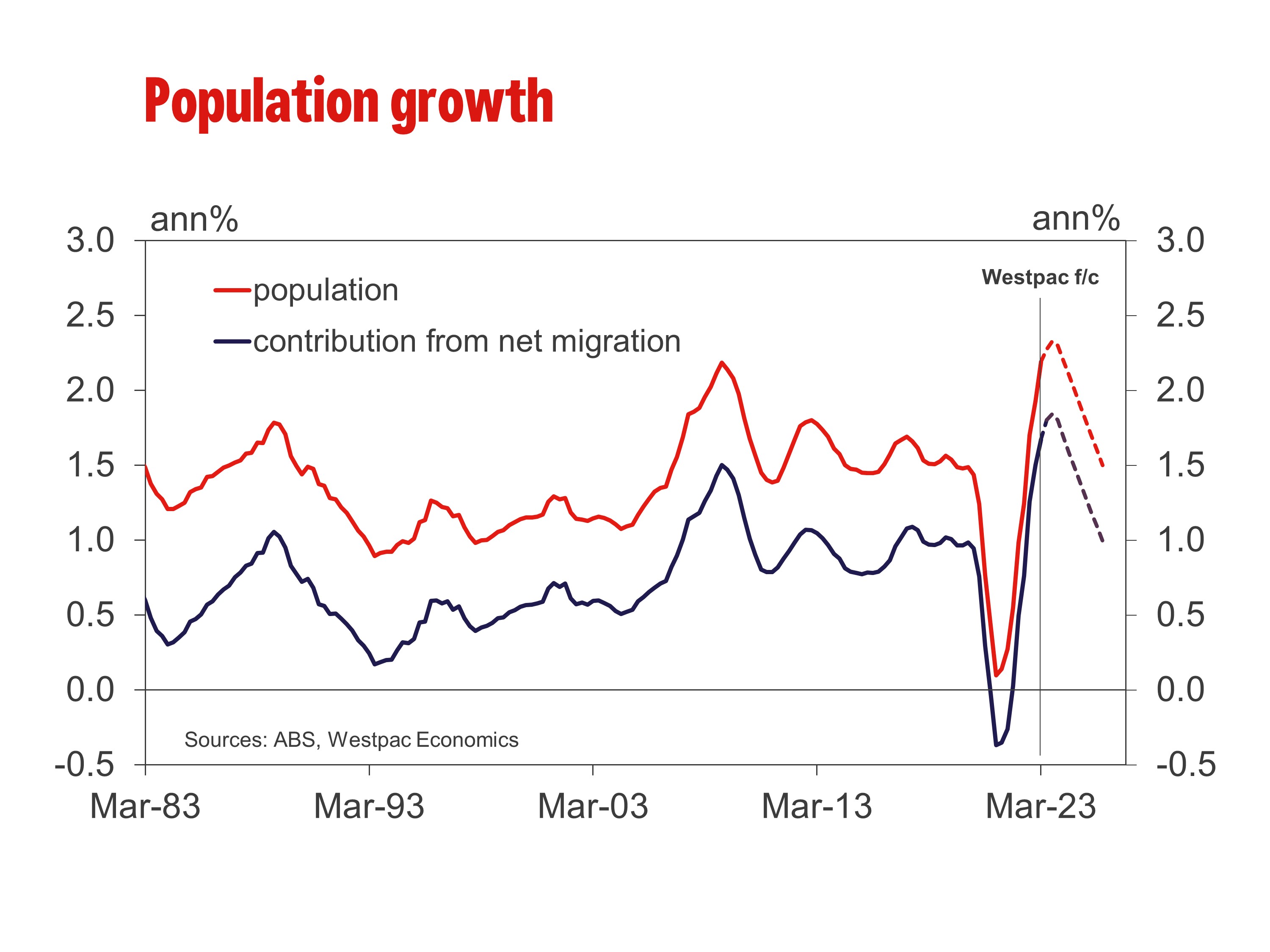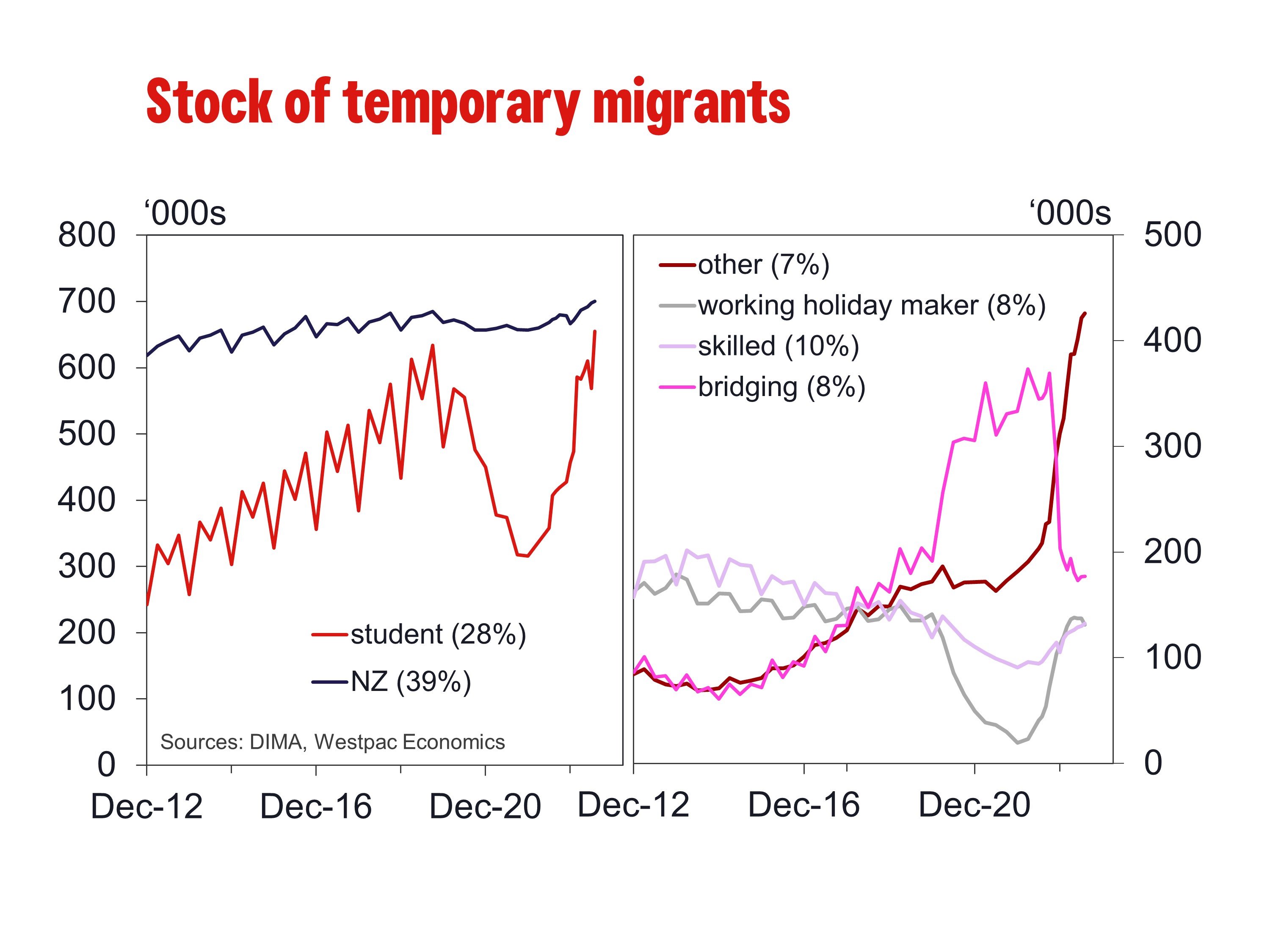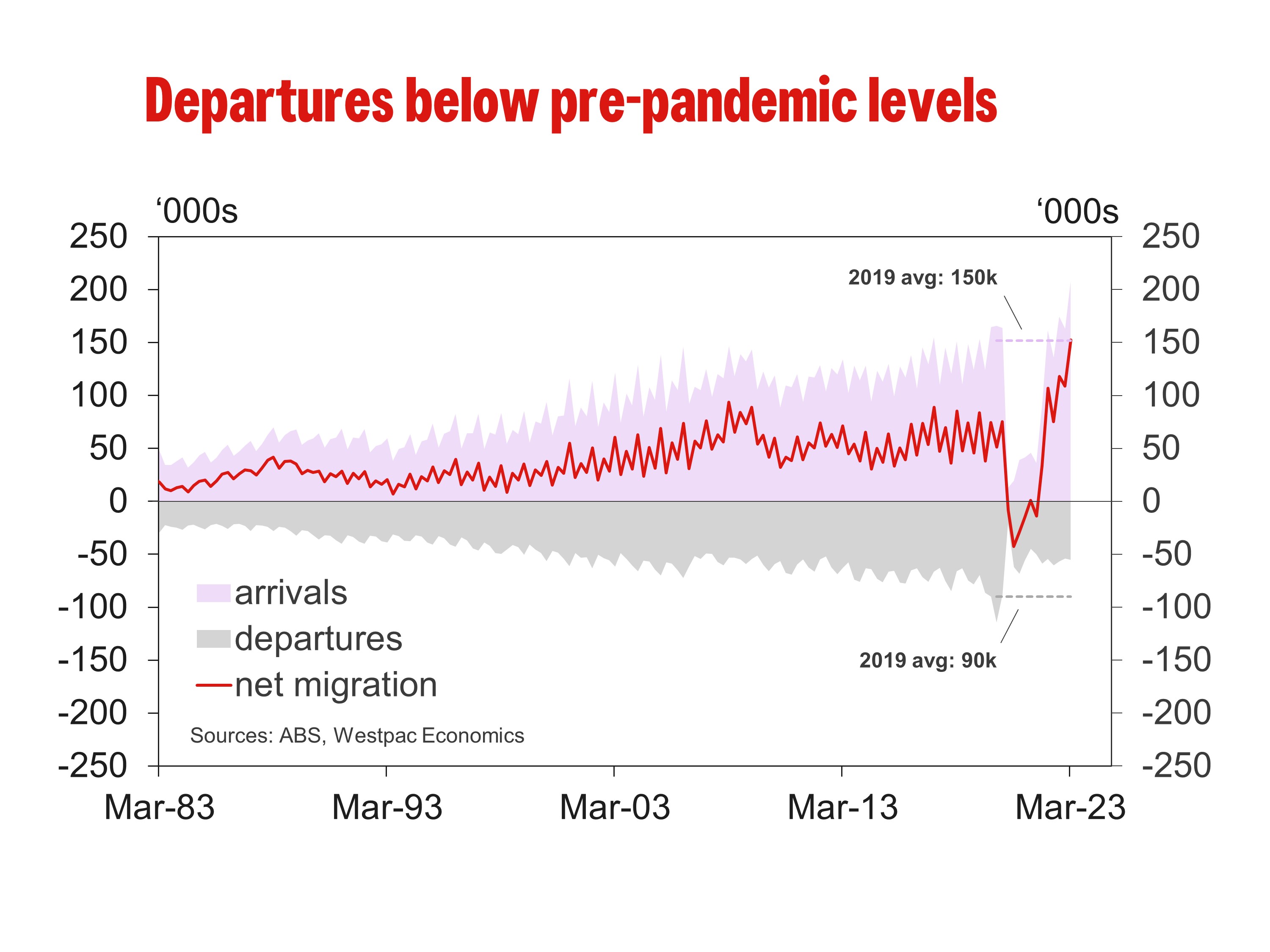Population growth is nearing its peak
The pandemic caused a sudden and extreme shift in Australia’s population dynamics. The migration-driven recovery in population growth has exhibited a considerable amount of strength so far this year, and it looks as though we are approaching its peak.

In the five years leading up to the onset of the pandemic, Australia’s net migration intake averaged roughly 235,000 per year. Upon the implementation of general border closures to limit the spread of COVID-19, net migration fell effectively flat over two years – with a net outflow of 5,000 in 2020 followed by a modest inflow of 6,800 in 2021.
Based on the pre-pandemic average, net migration would have amounted to around 470,000 over those two years had the pandemic not occurred.
In February 2022, Australia reopened its borders to the world. Westpac forecast a historic surge in net migration would unfold – the likes of which had not been seen since the post-WWII migration boom – amounting to +400,000 for 2022. Official data has since confirmed our view. Net migration printed +408,900 in 2022 and contributed 1.6ppts of the 2.0%yr jump in population growth.
We initially expected the pace of net migration to ease from its record pace in 2022, to +350,000 in 2023 and +275,000 in 2024. These forecasts were well above the Government’s at the time, which assumed net migration would only return to a pre-pandemic pace of +235,000.
However, it has become clear that the strength of population growth observed over the course of this year has far exceeded even our ambitious forecast.
Westpac now expects population growth to print 2.3%yr in 2023, 1.9%yr in 2024 and 1.5%yr in 2025.
Based on the Government’s updated forecast for natural increase – which assumes a return to pre-pandemic trends by 2023-24 – the above growth rates imply net migration will print in the realm of +475,000 in 2023, +375,000 in 2024 and +275,000 in 2025.
Against the pre-pandemic pace of around 235,000, these forecasts indicate an “excess” gain of 240,000 in 2023, 140,000 in 2024 and 40,000 in 2025.
Over the period of 2020 to 2025, we therefore estimate that net migration will be roughly 125,000 more than what would have been expected before COVID-19. In other words, by the end of this year, migration will have fully caught up for the losses observed over the COVID period, and will be outstripping its pre-COVID trajectory.
This is not the first time in our history whereby global events have seen such a rapid shift in migration dynamics. Towards the end of WWII, for example, net migration did not contribute positively to population growth from 1944-46. By 1949, net migration was contributing 1.8ppts of the 3.1%yr surge in population growth.
Updates on Australia’s estimated residential population (ERP) – including the contribution from net migration – are not particularly timely, being published with a six-month lag. The latest update, for March 2023, has population growth running at a 2.2%yr pace.
We have found that estimates of the working age population from the ABS Labour Force Survey (LFS) – which utilise a combination of ERP projections and other data sources, including information from the Department of Home Affairs – have become a more reliable indicator for total population growth over recent years, especially during periods of significant shifts in population dynamics.

As of the August LFS, working age population growth is running at a pace of 2.8%yr to August 2023, not materially different from the 2.7%yr pace from June 2023 but well above the 1.9%yr pace observed back in August 2022.
On our figuring, these results imply that total population growth lifted to 2.3%yr in the June quarter and, based on just August’s LFS observation, it will likely maintain that pace through the September quarter. Hence, our forecast for 2.3%yr in December 2023 implies that population growth, having accelerated sharply through 2022, has tapered towards its peak over the course of 2023.
Looking into 2024 and 2025, we anticipate a slowing in the pace of net migration, arising from both an easing in arrival flows and a pick-up in departures.
We believe that most of the slack will come through an easing in arrivals. This partly reflects an unwinding of the COVID-19 ‘catch-up’ – with the majority of those with delayed migration plans, as a consequence of the pandemic cycle through – but this also captures a shift in the migration policy stance, in response to the immense stress the pandemic and subsequent border reopening places on Australia’s migration system.
To better understand these dynamics, it is helpful to inspect how the stock of temporary migrants in Australia (excluding visitors) has evolved over recent years.
The two largest segments of our temporary migrant stock are foreign students (28%) and New Zealanders (39%). While these groups had vastly different pandemic experiences – the number of students in Australia nearly halved over two years – both groups have begun to move beyond pre-pandemic levels as of mid-2023.
Similarly, the number of individuals on working holiday maker and skilled employment visas – together accounting for roughly 18% of the temporary migrant stock – collapsed during the pandemic and have begun to find their footing, nearing pre-pandemic levels.
In the later portion of 2022 and into 2023, there has been a surge in “other” temporary migrants, from an average of roughly 170k over 2019 to 426k as of July 2023. Most of this lift centred on the Subclass 408 Pandemic Event visa, which provided support to working arrangements over the course of the pandemic. A similar dynamic was evident amongst bridging visas, but they have since moderated from their pandemic-era highs.

Many individuals utilised the Pandemic Event visa as a form of bridging visa, with numerous reports suggesting the visa approval process for certain visa categories remains restrictively slow. Indeed, according to data from the Department of Home Affairs, visa grant volumes for temporary skilled and working holiday maker visas have risen but not nearly to the degree that has been seen for foreign student visas.
Ultimately, we are left with temporary migrant stock which has largely returned to pre-pandemic levels, with the exception of a large portion of individuals bound to a Pandemic Event visa, who are contributing to Australia’s labour force but otherwise lack the economic security associated with other visas.
In response, the Government announced in early September that the Pandemic Event visa will only be open to applications from existing holders of this visa, with no further applicants from February 2024.
Over recent months, there have been several other policy announcements on the migration front. That includes the reinstatement of work-hour restrictions on student visas (from unlimited to 48hrs/fortnight) and the lift in the Temporary Skilled Migration Income Threshold (TSMIT) – the minimum rate an employer must undertake to pay sponsored workers under the temporary skills programme and the employer-sponsored permanent migration programme.
These developments aim to lower the risk of exploitation (as highlighted in the Migration Review) and will ultimately lower the amount of stress on the migration system by prioritising the stock of migrants current in Australia, rather than introducing policies that would sustain the historic pace of net migration and the strain it has caused on visa processing.
On the other hand, overseas departures have scope to lift further. At 227k over the year to March 2023, departure flows remain well below the five-year pre-pandemic average, at roughly 300k. The rise in departures will likely start with the Pandemic Event visa, as processing issues are resolved and some individuals return overseas. In time, we will begin to see a return to more normal dynamics for those who have arrived over the last couple of years, as students complete their courses (2 years for VET; 3 years for university) and temporary workers finish their sponsored terms.
Conclusion
The migration-driven recovery in population growth has exhibited a considerable amount of strength so far this year, and it looks as though we are approaching its peak.
Population growth has played an important role in the aggregate strength of our economy to date – without it, the economic outlook would have been much bleaker. Accounting for the forecast strength in population, together with our view on economic growth, our forecasts imply GDP per capita declines in the order of 1.1% in 2023 and 0.3% in 2024.
The ability for labour demand to soak up the surge in population growth so far has been remarkable. While our central view is for the pace of net migration to slow in 2024, we expect that the softening in labour demand – in response to the unfolding slowdown in the broader economy – will be greater. This will drive a rise in the unemployment rate over the next year, which we forecast will lift from a quarter-average of 3.8% by end-2023 to 4.7% by end-2024
Ryan Wells, Economist

Stay informed with Westpac IQ
Get the latest reports straight to your inbox.
Browse topics
Disclaimer
©2025 Westpac Banking Corporation ABN 33 007 457 141 (including where acting under any of its Westpac, St George, Bank of Melbourne or BankSA brands, collectively, “Westpac”). References to the “Westpac Group” are to Westpac and its subsidiaries and includes the directors, employees and representatives of Westpac and its subsidiaries.
Things you should know
We respect your privacy: You can view the New Zealand Privacy Policy here, or the Australian Group Privacy Statement here. Each time someone visits our site, data is captured so that we can accurately evaluate the quality of our content and make improvements for you. We may at times use technology to capture data about you to help us to better understand you and your needs, including potentially for the purposes of assessing your individual reading habits and interests to allow us to provide suggestions regarding other reading material which may be suitable for you.
This information, unless specifically indicated otherwise, is under copyright of the Westpac Group. None of the material, nor its contents, nor any copy of it, may be altered in any way, transmitted to, copied of distributed to any other party without the prior written permission of the Westpac Group.
Disclaimer
This information has been prepared by Westpac and is intended for information purposes only. It is not intended to reflect any recommendation or financial advice and investment decisions should not be based on it. This information does not constitute an offer, a solicitation of an offer, or an inducement to subscribe for, purchase or sell any financial instrument or to enter into a legally binding contract. To the extent that this information contains any general advice, it has been prepared without taking into account your objectives, financial situation or needs and before acting on it you should consider the appropriateness of the advice. Certain types of transactions, including those involving futures, options and high yield securities give rise to substantial risk and are not suitable for all investors. We recommend that you seek your own independent legal or financial advice before proceeding with any investment decision.
This information may contain material provided by third parties. While such material is published with the necessary permission none of Westpac or its related entities accepts any responsibility for the accuracy or completeness of any such material. Although we have made every effort to ensure this information is free from error, none of Westpac or its related entities warrants the accuracy, adequacy or completeness of this information, or otherwise endorses it in any way. Except where contrary to law, Westpac Group intend by this notice to exclude liability for this information. This information is subject to change without notice and none of Westpac or its related entities is under any obligation to update this information or correct any inaccuracy which may become apparent at a later date. This information may contain or incorporate by reference forward-looking statements. The words “believe”, “anticipate”, “expect”, “intend”, “plan”, “predict”, “continue”, “assume”, “positioned”, “may”, “will”, “should”, “shall”, “risk” and other similar expressions that are predictions of or indicate future events and future trends identify forward-looking statements. These forward-looking statements include all matters that are not historical facts. Past performance is not a reliable indicator of future performance, nor are forecasts of future performance. Whilst every effort has been taken to ensure that the assumptions on which any forecasts are based are reasonable, the forecasts may be affected by incorrect assumptions or by known or unknown risks and uncertainties. The ultimate outcomes may differ substantially from any forecasts.
Conflicts of Interest: In the normal course of offering banking products and services to its clients, the Westpac Group may act in several capacities (including issuer, market maker, underwriter, distributor, swap counterparty and calculation agent) simultaneously with respect to a financial instrument, giving rise to potential conflicts of interest which may impact the performance of a financial instrument. The Westpac Group may at any time transact or hold a position (including hedging and trading positions) for its own account or the account of a client in any financial instrument which may impact the performance of that financial instrument.
Author(s) disclaimer and declaration: The author(s) confirms that (a) no part of his/her compensation was, is, or will be, directly or indirectly, related to any views or (if applicable) recommendations expressed in this material; (b) this material accurately reflects his/her personal views about the financial products, companies or issuers (if applicable) and is based on sources reasonably believed to be reliable and accurate; (c) to the best of the author’s knowledge, they are not in receipt of inside information and this material does not contain inside information; and (d) no other part of the Westpac Group has made any attempt to influence this material.
Further important information regarding sustainability-related content: This material may contain statements relating to environmental, social and governance (ESG) topics. These are subject to known and unknown risks, and there are significant uncertainties, limitations, risks and assumptions in the metrics, modelling, data, scenarios, reporting and analysis on which the statements rely. In particular, these areas are rapidly evolving and maturing, and there are variations in approaches and common standards and practice, as well as uncertainty around future related policy and legislation. Some material may include information derived from publicly available sources that have not been independently verified. No representation or warranty is made as to the accuracy, completeness or reliability of the information. There is a risk that the analysis, estimates, judgements, assumptions, views, models, scenarios or projections used may turn out to be incorrect. These risks may cause actual outcomes to differ materially from those expressed or implied. The ESG-related statements in this material do not constitute advice, nor are they guarantees or predictions of future performance, and Westpac gives no representation, warranty or assurance (including as to the quality, accuracy or completeness of the statements). You should seek your own independent advice.
Additional country disclosures:
Australia: Westpac holds an Australian Financial Services Licence (No. 233714). You can access Westpac’s Financial Services Guide here or request a copy from your Westpac point of contact. To the extent that this information contains any general advice, it has been prepared without taking into account your objectives, financial situation or needs and before acting on it you should consider the appropriateness of the advice.
New Zealand: In New Zealand, Westpac Institutional Bank refers to the brand under which products and services are provided by either Westpac (NZ division) or Westpac New Zealand Limited (company number 1763882), the New Zealand incorporated subsidiary of Westpac ("WNZL"). Any product or service made available by WNZL does not represent an offer from Westpac or any of its subsidiaries (other than WNZL). Neither Westpac nor its other subsidiaries guarantee or otherwise support the performance of WNZL in respect of any such product. WNZL is not an authorised deposit-taking institution for the purposes of Australian prudential standards. The current disclosure statements for the New Zealand branch of Westpac and WNZL can be obtained at the internet address www.westpac.co.nz.
Singapore: This material has been prepared and issued for distribution in Singapore to institutional investors, accredited investors and expert investors (as defined in the applicable Singapore laws and regulations) only. Recipients of this material in Singapore should contact Westpac Singapore Branch in respect of any matters arising from, or in connection with, this material. Westpac Singapore Branch holds a wholesale banking licence and is subject to supervision by the Monetary Authority of Singapore.
Fiji: Unless otherwise specified, the products and services for Westpac Fiji are available from www.westpac.com.fj © Westpac Banking Corporation ABN 33 007 457 141. This information does not take your personal circumstances into account and before acting on it you should consider the appropriateness of the information for your financial situation. Westpac Banking Corporation ABN 33 007 457 141 is incorporated in NSW Australia and registered as a branch in Fiji. The liability of its members is limited.
Papua New Guinea: Unless otherwise specified, the products and services for Westpac PNG are available from www.westpac.com.pg © Westpac Banking Corporation ABN 33 007 457 141. This information does not take your personal circumstances into account and before acting on it you should consider the appropriateness of the information for your financial situation. Westpac Banking Corporation ABN 33 007 457 141 is incorporated in NSW Australia. Westpac is represented in Papua New Guinea by Westpac Bank - PNG - Limited. The liability of its members is limited.
U.S.: Westpac operates in the United States of America as a federally licensed branch, regulated by the Office of the Comptroller of the Currency. Westpac is also registered with the US Commodity Futures Trading Commission (“CFTC”) as a Swap Dealer, but is neither registered as, or affiliated with, a Futures Commission Merchant registered with the US CFTC. The services and products referenced above are not insured by the Federal Deposit Insurance Corporation (“FDIC”). Westpac Capital Markets, LLC (‘WCM’), a wholly-owned subsidiary of Westpac, is a broker-dealer registered under the U.S. Securities Exchange Act of 1934 (‘the Exchange Act’) and member of the Financial Industry Regulatory Authority (‘FINRA’). In accordance with APRA's Prudential Standard 222 'Association with Related Entities', Westpac does not stand behind WCM other than as provided for in certain legal agreements between Westpac and WCM and obligations of WCM do not represent liabilities of Westpac.
This communication is provided for distribution to U.S. institutional investors in reliance on the exemption from registration provided by Rule 15a-6 under the Exchange Act and is not subject to all of the independence and disclosure standards applicable to debt research reports prepared for retail investors in the United States. WCM is the U.S. distributor of this communication and accepts responsibility for the contents of this communication. Transactions by U.S. customers of any securities referenced herein should be effected through WCM. All disclaimers set out with respect to Westpac apply equally to WCM. If you would like to speak to someone regarding any security mentioned herein, please contact WCM on +1 212 389 1269. Investing in any non-U.S. securities or related financial instruments mentioned in this communication may present certain risks. The securities of non-U.S. issuers may not be registered with, or be subject to the regulations of, the SEC in the United States. Information on such non-U.S. securities or related financial instruments may be limited. Non-U.S. companies may not be subject to audit and reporting standards and regulatory requirements comparable to those in effect in the United States. The value of any investment or income from any securities or related derivative instruments denominated in a currency other than U.S. dollars is subject to exchange rate fluctuations that may have a positive or adverse effect on the value of or income from such securities or related derivative instruments.
The author of this communication is employed by Westpac and is not registered or qualified as a research analyst, representative, or associated person of WCM or any other U.S. broker-dealer under the rules of FINRA, any other U.S. self-regulatory organisation, or the laws, rules or regulations of any State. Unless otherwise specifically stated, the views expressed herein are solely those of the author and may differ from the information, views or analysis expressed by Westpac and/or its affiliates.
UK: The London branch of Westpac is authorised in the United Kingdom by the Prudential Regulation Authority (PRA) and is subject to regulation by the Financial Conduct Authority (FCA) and limited regulation by the PRA (Financial Services Register number: 124586). The London branch of Westpac is registered at Companies House as a branch established in the United Kingdom (Branch No. BR000106). Details about the extent of the regulation of Westpac’s London branch by the PRA are available from us on request.
This communication is not being made to or distributed to, and must not be passed on to, the general public in the United Kingdom. Rather, this communication is being made only to and is directed at (a) those persons falling within the definition of Investment Professionals (set out in Article 19(5) of the Financial Services and Markets Act 2000 (Financial Promotion) Order 2005 (the “Order”)); (b) those persons falling within the definition of high net worth companies, unincorporated associations etc. (set out in Article 49(2)of the Order; (c) other persons to whom it may lawfully be communicated in accordance with the Order or (d) any persons to whom it may otherwise lawfully be made (all such persons together being referred to as “relevant persons”). Any person who is not a relevant person should not act or rely on this communication or any of its contents. In the same way, the information contained in this communication is intended for “eligible counterparties” and “professional clients” as defined by the rules of the Financial Conduct Authority and is not intended for “retail clients”. Westpac expressly prohibits you from passing on the information in this communication to any third party.
European Economic Area (“EEA”): This material may be distributed to you by either: (i) Westpac directly, or (ii) Westpac Europe GmbH (“WEG”) under a sub-licensing arrangement. WEG has not edited or otherwise modified the content of this material. WEG is authorised in Germany by the Federal Financial Supervision Authority (‘BaFin’) and subject to its regulation. WEG’s supervisory authorities are BaFin and the German Federal Bank (‘Deutsche Bundesbank’). WEG is registered with the commercial register (‘Handelsregister’) of the local court of Frankfurt am Main under registration number HRB 118483. In accordance with APRA’s Prudential Standard 222 ‘Association with Related Entities’, Westpac does not stand behind WEG other than as provided for in certain legal agreements (a risk transfer, sub-participation and collateral agreement) between Westpac and WEG and obligations of WEG do not represent liabilities of Westpac. Any product or service made available by WEG does not represent an offer from Westpac or any of its subsidiaries (other than WEG). All disclaimers set out with respect to Westpac apply equally to WEG.
This communication is not intended for distribution to, or use by any person or entity in any jurisdiction or country where such distribution or use would be contrary to local law or regulation.
This communication contains general commentary, research, and market colour. The communication does not constitute investment advice. The material may contain an ‘investment recommendation’ and/or ‘information recommending or suggesting an investment’, both as defined in Regulation (EU) No 596/2014 (including as applicable in the United Kingdom) (“MAR”). In accordance with the relevant provisions of MAR, reasonable care has been taken to ensure that the material has been objectively presented and that interests or conflicts of interest of the sender concerning the financial instruments to which that information relates have been disclosed.
Investment recommendations must be read alongside the specific disclosure which accompanies them and the general disclosure which can be found here. Such disclosure fulfils certain additional information requirements of MAR and associated delegated legislation and by accepting this communication you acknowledge that you are aware of the existence of such additional disclosure and its contents.
To the extent this communication comprises an investment recommendation it is classified as non-independent research. It has not been prepared in accordance with legal requirements designed to promote the independence of investment research and therefore constitutes a marketing communication. Further, this communication is not subject to any prohibition on dealing ahead of the dissemination of investment research.

